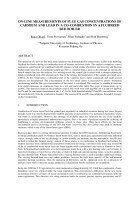Air monitoring
ON-LINE MEASUREMENTS OF FLUE GAS CONCENTRATIONS OF CADMIUM AND LEAD IN A CO-COMBUSTION IN A FLUIDIZED BED BOILER
Oct 06 2014
Author: Risto Oikari, Tomi Parviainen, Risto Eteläaho and Rolf Hernberg on behalf of CEM
ABSTRACT
The operation of a new on-line toxic metal analyser was demonstrated in connection to a pilot-scale bubbling fluidised bed boiler during co-combustion tests of biomass and waste fuels. The analyser comprises a novel continuous sampling device combined with DC-plasma excited atomic absorption spectroscopy and Zeeman background correction. A continuous sample gas flow is extracted from a process duct through an electrically heated sample line into the analyser. In a mixing nozzle the sample gas is mixed with a nitrogen plasma jet, which is produced with a DC-plasma torch. Due to the mixing, the temperature of the sample gas raised up to
2300 K. At this temperature a substantial part of the vaporous heavy metal compounds and small aerosol particles are decomposed. The concentration of the free metal atoms is measured by atomic absorption spectroscopy and the flue gas concentration of the metal is calculated. The analyser is capable to measure toxic metal emissions on continuous basis in a wet and particulate laden flue gases at temperatures up to 1100oC. The detection limits of the prototype used in this work were 0.04 mg/Nm3 for Cd and 0.4 mg/Nm3 for Pb and the maximum measurement rate 1 s-1. In the field demonstration, Cd and Pb concentrations were measured directly from the combustion chamber. The measured Cd and Pb concentrations depended strongly on fuel composition.
1. INTRODUCTION
Combustion of waste-based fuels has gained new popularity in industrial countries during last years. In past decades waste was mostly disposed into landfills and only a small portion of it, particularly hazardous waste, was burnt in incinerators. However, the shortage of available space has restricted the use of the landfills particularly in highly populated industrialised regions. But a far more significant reason for reducing of landfilling is serious environmental problems related to those sites. They have effects on the local environment such as poisoning of the soil and water reservoirs, but also global ones such as methane emission, which is one of the Green house gases (GHG).
In present days there is a strong international pressure to reduce the GHG emissions. Substituting fossil fuels in energy production partly by biomass-based waste fuels, such as municipal, agricultural and some industrial wastes, strongly reduces the net discharge of carbon dioxide and methane into the atmosphere. An efficient method to utilise the thermal energy content of these wastes is co-combustion in fluidised bed boilers. In modern facilities with combined heat and power production the energy conversion efficiency may exceed 90 %. In co-combustion waste-based fuels are burnt together with conventional ones such as biomass or fossil fuels. In fluidised bed combustors even heterogeneous waste fuels with a low heating value can be burnt. A main fuel (biomass or fossil fuels), which has a relatively high and constant heating value, is used to produce the base thermal load. A waste-based fuel with a varying heating value is used to produce additional energy. The varying thermal load does not induce problems, because the high heat capacity of the bed material smoothes thermal variations. Thus the operation of FB boilers can be optimised even for combustion of difficult waste fuels so that the energy production is maximised, but the emissions are minimised.
In the late 2000 the E.U. legislation for waste incineration changed notably [1]. Until then combustion of nonhazardous waste was allowed under the same regulations than conventional combustion. In the new waste incineration directive all types of waste incineration and co-combustion are controlled principally with the same regulations. This directive sets string emission limits for several gaseous species, particulates and 12 toxic metals (Hg, Cd, Tl, As, Cr, Co, Cu, Mn, Ni, Pb, Sb and V). It also requires frequent emission measurements and a close control of operation conditions.
Conventionally, toxic metal emissions are measured by wet chemical sampling and subsequent laboratory analysis. However, this is a laborious and time-consuming technique, which has also several uncertainties. There was a discussion to require continuous emission monitoring (CEM) for mercury in the new waste incineration directive. However, it was still abandoned because of a lack of suitable measurement methods. On contrary, in the U.S. CEMS for several metals (Hg, Cd, Pb, As, Be, Cr) will be required in the near future for hazardous waste incineration [2]. This evident need of CEMS for metals has stimulated development work of such measurement techniques. Main techniques studied for that purpose are microwave induced plasma [3,4], inductively coupled plasma [5-8], laser induced plasma [9-10], spark induced plasma [11], laser induced fluorescence [12-14], cavity ringdown spectroscopy [5] and X-ray fluorescence [15].
In this paper we present a versatile on-line toxic metal emission analyser, which is developed particularly for combustion research, but which can be utilised also for continuous emission monitoring. The constructed analyzer prototype was tested in connection to a 2 MW bubbling fluidised bed boiler. In the tests mixtures of plastic waste and wood chips were burnt. Cadmium and lead concentrations were measured directly from the combustion chamber to demonstrate the capability of the analyser.
Digital Edition
AET 28.4 Oct/Nov 2024
November 2024
Gas Detection - Go from lagging to leading: why investment in gas detection makes sense Air Monitoring - Swirl and vortex meters will aid green hydrogen production - Beyond the Stack: Emi...
View all digital editions
Events
Jan 12 2025 Abu Dhabi, UAE
Jan 14 2025 Abu Dhabi, UAE
Jan 20 2025 San Diego, CA, USA
Carrefour des Gestions Locales de L'eau
Jan 22 2025 Rennes, France
Safety, Health & Wellbeing LIVE
Jan 22 2025 Manchester, UK















